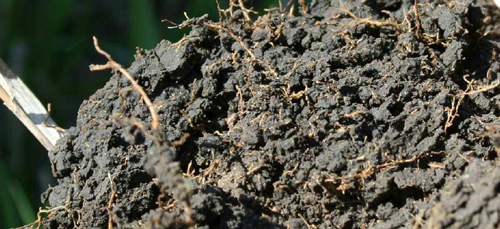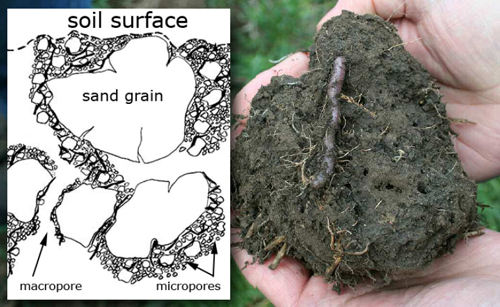Soil Structure and Macropores
What it is: Sand, silt and clay particles are the primary mineral building blocks of soil. Soil structure is the combination or arrangement of primary soil particles into aggregates. Using aggregate size, shape and distinctness as the basis for classes, types and grades, respectively, soil structure
describes the manner in which soil particles are aggregated. Soil structure affects water and air movement through soil, greatly influencing soil's ability to sustain life and perform other vital soil functions.
Soil pores exist between and within aggregates and are occupied by water and air. Macropores are large soil pores, usually between aggregates, that are generally greater than 0.08 mm in diameter. Macropores drain freely by gravity and allow easy movement of water and air. They provide habitat for soil organisms and plant roots can grow into them. With diameters less than 0.08 mm, micropores are small soil pores usually found within structural aggregates. Suction is required to remove water from micropores.

Photo: Crumbly structure of surface soil is associated with adequate organic matter content.
Why it is important: Important soil functions related to soil structure are: sustaining biological productivity, regulating and partitioning water and solute flow, and cycling and storing nutrients. Soil structure and macropores are vital to each of these functions based on their influence on water and air exchange, plant root exploration and habitat for soil organisms. Granular structure is typically associated with surface soils, particularly those with high organic matter. Granular structure is characterized by loosely packed, crumbly soil aggregates and an interconnected network of macropores that allow rapid infiltration and promote biological productivity. Structure and pore space of subsurface layers affects drainage, aeration, and root penetration. Platy structure is often indicative of compaction.
Specific problems that might be caused by poor function: Clay soils with poor structure and reduced infiltration may experience runoff, erosion, and surface crusting. On-site impacts include erosion-induced nutrient and soil loss and poor germination and seedling emergence due to crusted soil. Off-site impacts include reduced quality of receiving waters due to turbidity, sedimentation and nutrient enrichment. Water entry into a sandy soil can be rapid, but subsurface drainage of sandy soils with poor structure can also be rapid such that the soil cannot hold water needed for plant growth or biological habitat.
Practices that lead to poor soil structure include:
- Disturbance that exposes soil to the adverse effects of higher than normal soil drying, raindrop and rill erosion, and wind erosion
- Conventional tillage and soil disturbance that accelerates organic matter decomposition
- Residue harvest, burning or other removal methods that prevent accumulation of soil organic matter
- Overgrazing that weakens range and forage plants and leads to declining root systems, poor growth and bare soil
- Equipment or livestock traffic on wet soils
- Production and irrigation methods that lead to salt or sodium accumulation in surface soils
What you can do: Practices that provide soil cover, protect or result in accumulation of organic matter, maintain healthy plants, and avoid compaction improve soil structure and increase macropores.
Practices resulting in improved soil structure and greater occurrence of macropores favorable to soil function include:
- Cover Crop
- Conservation Crop Rotation
- Irrigation Water Management
- Prescribed Grazing
- Residue and Tillage Management
- Salinity and Sodic Soil Management
For more information go to Soil Management Practices.

Photo: High residue and cover crops contribute organic matter to soil, while no-till management helps protect organic matter and allow accumulation. Organic matter provides food for earthworms and other soil biota. All play a role in developing or protecting soil structure and macropores to help soil function at a high level. Inset shows relationship of macro- and micropores to soil aggregates.
Evaluating soil structure and macropores:
Soil structure is described in the Soil Quality Test Kit Guide, Section I, Chapter 11, pp. 23 – 27. See Section II, Chapter 10, p. 76 for interpretation of observations.
